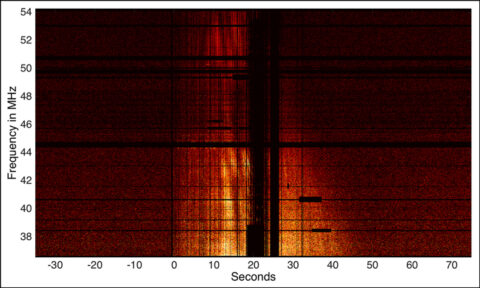Source: Journal of Geophysical Research: Space Physics
For millennia, humans have cast their gaze to the cosmos and watched in awe as meteors streak across the night sky, leaving behind glowing trails of ionized air and superheated fragments of debris. But in 2014, scientists discovered that the brightest fireball meteors don’t just emit heat and light as they fall through the atmosphere—they also emit radio waves.
This discovery came as something of a surprise. Meteors have been known to emit short radio bursts at very low frequencies and also some electromagnetic pulses lasting less than a microsecond. But these high-frequency radio emissions last anywhere from 10 seconds to well over 3 minutes, and their origin has stumped scientists.
Now the team has reported more detailed observations that they think may get them closer to the answer. Obenberger et al. used an array of radio telescopes in the New Mexico desert to tune into these brief broadcasts, intercepting emissions from two fireball meteors in October 2014. They measured their signal strength across a swath of the high-frequency radio spectrum and found that it was strongest below 25 megahertz, with a mostly smooth falloff toward higher frequencies.

The measurements have allowed the team to discount one possibility: that it could be reflected radio signals, from either the ground or celestial objects like the galactic core. This was a reasonable guess—radio operators can bounce transmissions off of meteor ionization trails to boost signal range, a technique used by militaries, researchers, and ham radio operators alike. But if that were the case here, as winds blow the trail across the sky, the signal strength across the spectrum should spike and fall out sporadically. In addition, human-made signals are typically very narrow—in contrast, these new data show an extremely broadband signal that is relatively smooth over time.
Using these measurements, the team thinks that the meteor itself is generating the radio waves. As the meteoroid streaks through the mesosphere, shedding mass and ionizing the air, it may create high-velocity electrons in its wake. These energetic electrons could strike the surrounding plasma like wind on an ocean—whipping up plasma waves that would generate the radio emissions the team detected.
During one of the fireballs, the team also picked up bursts of polarized light that appeared for roughly 10 seconds, their frequency decreasing over time. The rate at which the pulse frequency decreases over time resembles what the scientists would expect for an expanding plasma, which they interpret as further evidence that the radio waves originate from the meteor trail. The pulses could be the result of clumps of dense, hot plasma that then expand into a broader trail.
The team expects to get even more detailed data in the near future; the facility they used, the Long Wavelength Array, is currently expanding to include a second station about 75 kilometers away. When that comes online, the team will be able to precisely triangulate the trajectories of the meteors and take detailed images to measure the trail’s expansion. (Journal of Geophysical Research: Space Physics, doi:10.1002/2015JA021229, 2015)
—Mark Zastrow, Freelance Writer
Citation: Zastrow, M. (2016), Decoding the radio transmissions of shooting stars, Eos, 97, doi:10.1029/2016EO044055. Published on 26 January 2016.
Text © 2016. The authors. CC BY-NC 3.0
Except where otherwise noted, images are subject to copyright. Any reuse without express permission from the copyright owner is prohibited.

